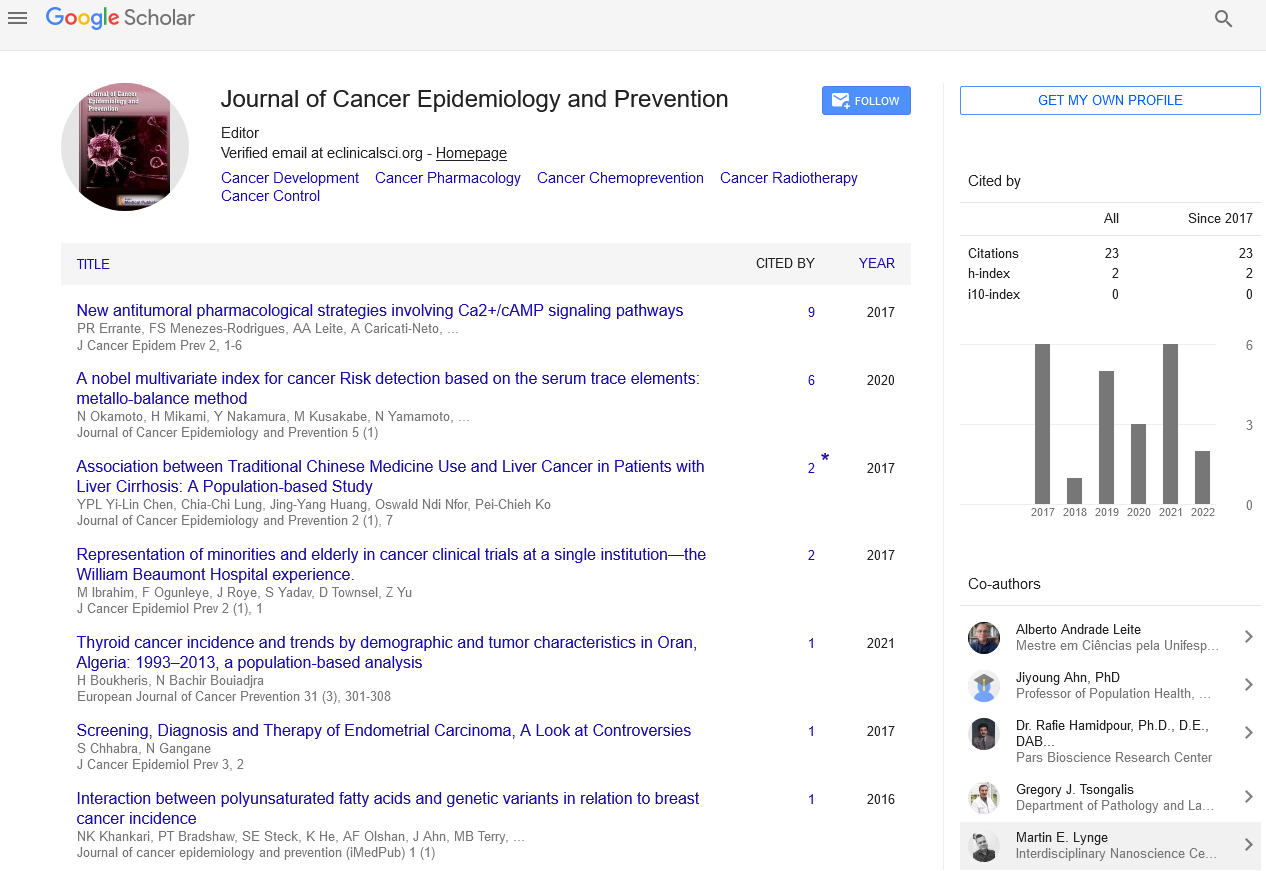Commentry - (2021) Volume 6, Issue 6
A Brief Note on Side Effects of Cancer Radiation Therapy
Gregory J Tsongalis*
Department of Pathology and Laboratory Medicine, DartmouthHitchcock Medical Center and the Norris Cotton Cancer Center, Lebanon, NH, USA
*Correspondence:
Gregory J Tsongalis, Department of Pathology and Laboratory Medicine,
DartmouthHitchcock Medical Center and the Norris Cotton Cancer Center, Lebanon, NH,
USA,
Email:
Received: 03-Dec-2021
Published:
24-Dec-2021
Description
Radiation treatment or radiotherapy, also known as
compressed RT, RTx, or XRT, is a type of treatment that uses
ionising radiation to treat or kill malignant cells. It is typically
done by using a straight gas pedal. Radiation therapy may be
beneficial for several disorders if they are limited to a specific
region of the body. It could be utilized as part of an adjuvant
treatment to prevent growth associated with the medical
procedure to remove a cancer in the body (for example, the
early stages). Radiation therapy is complementary
to chemotherapy and has been used in the treatment of certain
diseases before and after chemotherapy. Radiation oncology is a
type of cancer treatment that uses radiotherapy. In this area, a
radiation oncologist is a medical specialist.
Because of its ability to control oncogenesis, radiation therapy
is commonly used to treat cancer which is harmful. By damaging
the DNA of tumour tissues, ionising radiation causes cancer. And
protect ordinary tissues (such as skin or organs that must be
exposed to radiation in order to treat cancer), generated
radiation beams are directed from a few sites of permeability to
converge at the tumour, resulting in a much larger absorbed
fraction there than the adjacent tissue. Apart from the growth,
the depleting lymph bumps may also be included in the
radiation fields if they are clinically or radiologically associated
with cancer, or if there is a risk of subclinical hazardous spread.
It's critical to have a barrier of tissue around the tumour to
adjust for vulnerabilities in the day-to-day configuration and
internal cancer migration. Inner growth (for example, breathe
and urinary filling) and external development both can
contribute to these risks.
Radiation treatment is itself easy. Some low-portion palliative
therapies (for instance, radiation treatment to hard metastases)
cause insignificant or no secondary effects, albeit momentary
torment discharge up can be knowledgeable about the days
following therapy because of oedema compacting nerves in the
treated region. Higher doses can result in different side effects
during treatment (strong secondary effects), months or years
after treatment (long-term aftereffects), or subsequent retherapy (aggregate secondary effects).The nature, seriousness,
and life span of secondary effects relies upon the organs that get
the radiation, the actual therapy (kind of radiation, portion,
fractionation, simultaneous chemotherapy), and the patient.
Most secondary effects are unsurprising and anticipated.
Secondary effects from radiation are typically restricted to the
space of the patient's body that is under therapy. Aftereffects
are portion subordinate; for instance higher dosages of head
and neck radiation can be related with cardiovascular
inconveniences, thyroid brokenness, and pituitary hub
dysfunction. Modern radiation treatment means to lessen
secondary effects to a base and to assist the patient with
understanding aftereffects that are unavoidable.
Sickness and retching
This isn't a general symptom of radiation treatment; it's more
often associated with stomach or midsection therapy (which
usually responds a few hours later), or with radiation treatment
to specific uncontrollable shaking structures in the head during
therapy of specific head and neck growths, most commonly the
internal ear vestibules. Just like any unpleasant therapy, a few
individuals vomit up spontaneously or even fully expect it during
radiotherapy; however, this is seen as a behavioural reaction.
Antiemetic’s can be used to treat any type of illness.
Sores in the mouth, throat, and stomach
Temporary pain and ulceration in the mouth and throat are
frequent when the head and neck area is treated. If the
condition is severe, the patient may require painkillers as well as
nutritional support/food supplements. If the esophagus is
treated directly or, more typically, if it receives a dosage of
collateral radiation during lung cancer treatment, it can become
painful. Collateral radiation can cause gastric, stomach, or
duodenal ulcers while treating liver cancers and metastases.
Non-targeted delivery (reflux) of the radioactive agents being
infused is a typical cause of collateral radiation. There are
methods, procedures, and equipment available to reduce the
likelihood of this type of negative side effect.
Citation: Tsongalis GJ (2021) A Brief Note on Side Effects of Cancer Radiation Therapy. J Cancer Epidemiol Prev. Vol.6 No.6:008.
Copyright: This is an open access article distributed under the terms of the Creative Commons Attribution License, which permits unrestricted use, distribution, and reproduction in any medium, provided the original work is properly cited.

